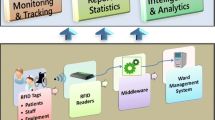Abstract
In healthcare facilities most of the daily activities require strict coordination between clinicians, who often operate under heavy workloads and minimal workforce conditions in environments filled with increasingly complex technology. Ubiquitous Computing applications constitute a suitable solution for both reducing medical costs and improving patient safety by better supporting clinical processes. In this study we introduce an intelligent infrastructure for smart hospitals which implements basic services to optimize medical staff/patient interactions and grants ubiquitous and transparent access to clinical data stored in standard clinical databases. This infrastructure relies on the integration of Radio Frequency IDentification (RFID) and photosensor technologies to identify, locate and track clinicians and patients equipped with mobile devices and wearable RFID tags.






Similar content being viewed by others
References
Al Nahas H, Deogun JS (2007) Radio frequency identification applications in smart hospitals. In: CBMS ’07: twentieth IEEE international symposium on computer-based medical systems. IEEE Computer Society, Washington, DC, pp 337–342
Bacheldor B (2007) HCA North Florida expands its RTLS to track patients. http://www.rfidjournal.com/article/articleview/3615/1/1/
Bacheldor B (2007) Tags track surgical patients at Birmingham Heartlands Hospital. http://www.rfidjournal.com/article/articleview/3222/1/1/
Bång M, Larsson A, Eriksson H (2003) NOSTOS: a paper-based ubiquitous computing healthcare environment to support data capture and collaboration. In: Proceedings of the AMIA annual symposium. Washington, DC, pp 46–50
Bardram JE (2004) Applications of context-aware computing in hospital work: examples and design principles. In: SAC ’04: proceedings of the 2004 ACM symposium on applied computing. ACM, New York, pp 1574–1579
Borriello G, Stanford V, Narayanaswami C, Menning W (2007) Guest editors’ introduction: pervasive computing in healthcare. IEEE Pervasive Computing 6:17–19
Casimiro A, Kaiser J, Veríssimo P (2004) An architectural framework and a middleware for cooperating smart components. In: CF ’04: proceedings of the 1st conference on computing frontiers. ACM, New York, pp 28–39
Chen PJ, Chen YF, Chai SK, Huang YF (2009) Implementation of an RFID-based management system for operation room. IEEE Computer Society, Washington, DC, pp 2933–2938
Coronato A, De Pietro G, Gallo L (2008) An agent based platform for task distribution in virtual environments. J Systems Archit 14(9):877–882
Coronato A, Della Vecchia G, De Pietro G (2006) An RFID-based access and location service for pervasive grids, vol 409. Springer, Berlin, pp 601–608
Coronato A, Esposito M (2008) Towards an implementation of smart hospital: a localization system for mobile users and devices. In: PERCOM ’08: proceedings of the 2008 sixth annual IEEE international conference on pervasive computing and communications. IEEE Computer Society, Washington, DC, pp 715–719
De P, Basu K, Das SK (2004) An ubiquitous architectural framework and protocol for object tracking using RFID tags. In: MobiQuitous ’04: proceedings of the first annual international conference on mobile and ubiquitous systems. IEEE Computer Society, Los Alamitos, pp 174–182
Della Vecchia G, Esposito M (2009) A pervasive system for nuclear medicine department. Wirel Pers Commun (2009). doi:10.1007/s11277-009-9789-x
Erl T (2009) SOA design patterns. Prentice Hall, Upper Saddle River
Favela J, Tentori M, Castro LA, Gonzalez VM, Moran EB, Martínez-García AI (2007) Activity recognition for context-aware hospital applications: issues and opportunities for the deployment of pervasive networks. Mobile Networks and Applications 12(2–3):155–171
Gallo L, De Pietro G, Coronato A, Marra I (2008) Toward a natural interface to virtual medical imaging environments. In: AVI ’08: proceedings of the working conference on advanced visual interfaces. ACM, New York pp. 429–432
Gallo L, Minutolo A, De Pietro G (2010) A user interface for VR-ready 3D medical imaging by off-the-shelf input devices. Comput Biol Med 40(3):350–358
Halamka J (2003) Early experiences with positive patient identification. J Healthc Inf Manag 20(1):25–27
Holzinger A, Schwaberger K, Weitlaner M (2005) Ubiquitous computing for hospital applications: RFID-applications to enable research in real-life environments. In: COMPSAC ’05: proceedings of the 29th annual international computer software and applications conference. IEEE Computer Society, Washington, DC, pp 19–20
IFIP WG 10.4 on dependable computing and fault tolerance. http://www.dependability.org/wg10.4/
Lahtela A, Hassinen M (2009) Requirements for radio frequency identification in healthcare. In: MIE ’09: proceedings of the XXIInd international congress of medical informatics in a united and healthy Europe. IOS Press, Amsterdam, pp 720–724
Pietzuch PR, Bacon J (2002) Hermes: a distributed event-based middleware architecture. In: ICDCSW ’02: proceedings of the 22nd international conference on distributed computing systems. IEEE Computer Society, Washington, DC, pp 611–618
Satoh I (2004) Linking physical worlds to logical worlds with mobile agents. In: MDM ’04: proceedings of the IEEE international conference on mobile data management. IEEE Computer Society, Los Alamitos, p 332
Satoh I (2005) A location model for pervasive computing environments. In: PERCOM ’05: proceedings of the third IEEE international conference on pervasive computing and communications. IEEE Computer Society, Washington, pp 215–224
Satyanarayanan M (2001) Pervasive computing: vision and challenges. IEEE Pers Commun 8:10–17
Schimpff SC (2007) Improving operating room and perioperative safety: background and specific recommendations. Surgical Innovation 14:127–135
Skov B, Høegh T (2006) Supporting information access in a hospital ward by a context-aware mobile electronic patient record. Personal and Ubiquitous Computing 10(4):205–214
Varshney U (2003) Pervasive healthcare. Computer 36(12):138–140
Wang SW, Chen WH, Ong CS, Liu L, Chuang YW (2006) RFID application in hospitals: a case study on a demonstration rfid project in a taiwan hospital. In: HICSS ’06: proceedings of the 39th annual Hawaii international conference on system sciences. IEEE Computer Society, Washington, DC, p 184.1
Yu W, Ray P, Motoc T (2006) A RFID technology based wireless mobile multimedia system in healthcare. In: HEALTHCOM 2006: the 8th international conference on e-health networking, applications and services. IEEE Computer Society, Los Alamitos, pp 1–8
Author information
Authors and Affiliations
Corresponding author
Rights and permissions
About this article
Cite this article
Vecchia, G.D., Gallo, L., Esposito, M. et al. An infrastructure for smart hospitals. Multimed Tools Appl 59, 341–362 (2012). https://doi.org/10.1007/s11042-010-0695-8
Published:
Issue Date:
DOI: https://doi.org/10.1007/s11042-010-0695-8




